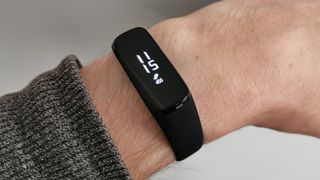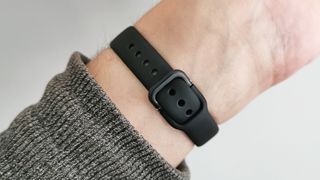TechRadar Verdict
The Galaxy Fit e does all the basics and then some – steps, sleep, heart rate, even phone notifications. It looks relatively stylish too, for a budget fitness tracker, but the real icing on the cake is that low, low price.
Pros
- +
Won't cost you much at all
- +
Accurate activity tracking
- +
Lightweight and comfortable
Cons
- -
Two apps needed
- -
Limited international availability
- -
Battery life can vary
Why you can trust TechRadar
If you're in the market for a wearable to track your fitness and activities in 2019, you can go for a fully fledged smartwatch, or for a simpler, more modest fitness tracker. There's also a sub-group forming: the super-cheap fitness tracker.
With the likes of Xiaomi and other Chinese brands pushing trackers that barely make any dent on your bank balance, the question is why you would pay any more if you just want the basics of step counting and sleep tracking?
And so comes the Samsung Galaxy Fit e, the cheapest and most basic fitness tracker Samsung has on the market now. It covers the basics, which even extend to limited sleep and heart rate tracking, but there are some compromises as well to hit a cheap price point.
It's one step below the Samsung Galaxy Fit, which was launched at the same time: it ditches the color screen, the wireless charging, and quick replies to phone messages.
Samsung Galaxy Fit e price and release date

- Yours for a mere £35
- Three different colors available
- Only in the UK and India for now
If you're looking to get a Samsung Galaxy Fit e strapped to your wrist then prices start at £35 (roughly $44 / AU$63). For now the tracker isn't available in the US or Australia, so it's only UK buyers who can take advantage of the Fit e's low-cost activity tracking.
The wearable is also exclusive to Argos at the time of writing – you can't buy it direct from Samsung at the moment (although there's always eBay). Black, white and yellow are your choices of band color, and there's only one size to choose from.
At that price the Samsung Galaxy Fit e is going right up against the budget trackers on the market, though it's by no means the cheapest of these bargain basement models.
It took a while for Samsung to get the Galaxy Fit e on sale, but it's available to buy now in the UK. We haven't heard any hints from the manufacturer that a launch in the US or Australia is imminent, though India is one other location where you can pick it up.
Design and display

- Lightweight and comfortable
- Monochrome 0.74-inch screen
- Choice of three colors
Shopping at this price point, you're hardly going to expect the fitness tracker with the most luxurious feel or the most premium of materials, but the Samsung Galaxy Fit e is actually better than you might expect in the design department.
Okay it's still just a band of rubber (in either black, white or yellow), but it feels good to wear even after an hour of 5-a-side football or a morning jog up and down the canal. You're not going to be irritated by it, or even notice it's there most of the time.
The strap fastening is one of the more intelligent and robust we've seen in recent years – how the strap connects is more important than you might think in how practical a strap is – and the Galaxy Fit e can be fastened and unfastened in a second.
It's not a particularly svelte device, with the heart rate monitor and other sensors adding some bulk above your wrist, but it's not an ugly device either: it's hardly something you're going to be scrabbling to take off when you're in polite company. Put it this way – we've seen fitness wearables that look a lot worse.
If you're more of a discreet type then the black band is the one to go for. Fans of bold colors or those with a more extroverted disposition can opt for the yellow or the white, but all the functions and features are the same across the board.

One of the features cut from the main Galaxy Fit is the wireless charging, so you get – joy of joys – another strange-looking USB charger. Plug one end into a laptop or a charging station or a mains adaptor (you don't get one in the box), and the fitness tracker rather awkwardly snaps into the other end. It's not great and the cable isn't very long but it'll do – and you are only paying £35 for this.
And really that's the bottom line when you're considering any aspect of the Samsung Galaxy Fit e, from its design to its accuracy – it's not expensive at all. The design and feel of the tracker is better than you would expect from the price, and that's all you can ask for really.
Another way you can tell the difference between the Galaxy Fit and the Galaxy Fit e is that this cheaper model goes for a monochrome rather than a color screen. It's a compromise we think is fine – you're hardly going to watch Netflix on your fitness tracker – and the display does a good job of showing the time and your essential fitness statistics.
The display measures 0.74 inches and isn't a touchscreen, though you can tap on the device to cycle between stats. It does light up when you lift your wrist and this works well and consistently – very useful when you're mid-jog.
As you would expect, it's a struggle to read the display in bright sunshine outdoors, but this isn't a problem that's exclusive to the Samsung Galaxy Fit e. Most of the time the wearable is going to give you exactly the info you need.
Overall you're unlikely to be disappointed by the fit and the finish of the Galaxy Fit e. It doesn't scream style and quality, but it's comfortable and lightweight to wear, and the choice of three colors gives you some flexibility in the design department.
Image Credit: TechRadar

Dave is a freelance tech journalist who has been writing about gadgets, apps and the web for more than two decades. Based out of Stockport, England, on TechRadar you'll find him covering news, features and reviews, particularly for phones, tablets and wearables. Working to ensure our breaking news coverage is the best in the business over weekends, David also has bylines at Gizmodo, T3, PopSci and a few other places besides, as well as being many years editing the likes of PC Explorer and The Hardware Handbook.

